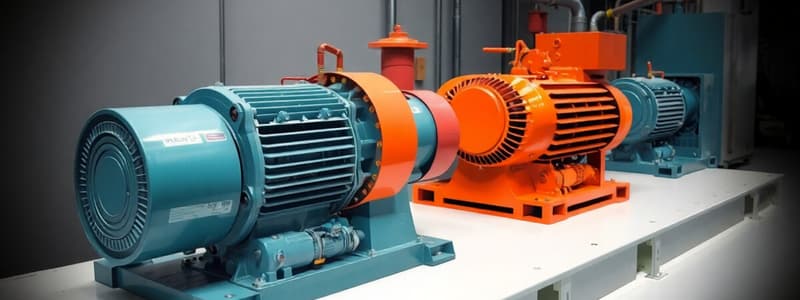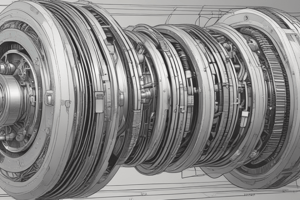Podcast
Questions and Answers
What does the output voltage of an elementary generator depend on?
What does the output voltage of an elementary generator depend on?
- The length of the conductor within the magnetic field (correct)
- The amount of current flowing through the circuit
- The purity of the conductor material
- The type of magnetic material used
What component is used in a DC generator to convert alternating current to direct current?
What component is used in a DC generator to convert alternating current to direct current?
- Inductor
- Commutator (correct)
- Conductor
- Rectifier
Which of the following factors does NOT affect the amount of voltage generated in a conductor within a magnetic field?
Which of the following factors does NOT affect the amount of voltage generated in a conductor within a magnetic field?
- Temperature of the conductor (correct)
- Speed at which the conductor is moved
- Angle at which the conductor cuts the magnetic field
- Strength of the magnetic field
What is the fundamental principle that explains how voltage is induced in a conductor when it moves within a magnetic field?
What is the fundamental principle that explains how voltage is induced in a conductor when it moves within a magnetic field?
What is the formula for calculating the back electromotive force (Eg) in a long shunt compound wound DC generator?
What is the formula for calculating the back electromotive force (Eg) in a long shunt compound wound DC generator?
What is the name of the device that collects induced emf from a rotating coil in an elementary generator?
What is the name of the device that collects induced emf from a rotating coil in an elementary generator?
Which method is NOT commonly used for speed control in DC motors?
Which method is NOT commonly used for speed control in DC motors?
According to Fleming's Right-Hand Rule, what does the thumb represent?
According to Fleming's Right-Hand Rule, what does the thumb represent?
What principle does Lenz's Law illustrate in relation to generated electromotive force?
What principle does Lenz's Law illustrate in relation to generated electromotive force?
What does the 'Rse' in a compound wound DC generator represent?
What does the 'Rse' in a compound wound DC generator represent?
Flashcards
Generator Principle
Generator Principle
A device that converts rotational or mechanical energy into electrical energy by using a conductor rotating in a magnetic field.
Elementary Generator
Elementary Generator
The simplest generator type, consisting of a wire loop that rotates within a magnetic field, producing an induced electromotive force (EMF).
AC Generator Output
AC Generator Output
An AC generator produces an alternating voltage, which periodically changes polarity during one rotation cycle.
DC Generator
DC Generator
Signup and view all the flashcards
Commutator
Commutator
Signup and view all the flashcards
Series Wound Generator
Series Wound Generator
Signup and view all the flashcards
Compound Wound Generator
Compound Wound Generator
Signup and view all the flashcards
Long Shunt vs. Short Shunt
Long Shunt vs. Short Shunt
Signup and view all the flashcards
DC Motor Working Principle
DC Motor Working Principle
Signup and view all the flashcards
DC Motor Function
DC Motor Function
Signup and view all the flashcards
Study Notes
Electric Machines
- Electric machines convert energy.
- Generators convert mechanical energy into electrical energy.
- Motors convert electrical energy into mechanical energy.
- Both operate via magnetic field interaction with windings.
- Electric machines are divided into AC and DC machines.
Types of Electric Machines
- AC machines
- DC machines
Parts of Electric Machines
- Stationary members (stator)
- Rotating members (rotor)
- Air gap (separates stator and rotor)
- Rotor and stator are magnetically coupled.
Principle of Operation of DC Machines
- Motors and generators use two basic principles:
- Interaction between magnetic poles (attraction or repulsion).
- Current flow in conductor creates magnetic field, and relative motion induces emf.
Basic Laws
- When current flows through a coil, a magnetic field is generated.
- Faraday's effect: Voltage = Potential to Move Charge (volts), Current = Charge Movement , Resistance = Potential/Current, Power = Current X Voltage
Faraday's Law
- The induced voltage (e) is equal to the rate of change of flux (Φ) multiplied by the number of turns (N).
e = N dΦ/dt
- B = magnetic flux density (in teslas)
- L = length of the conductor
- v = relative velocity between the wire and flux (meters/second).
e = BLv
Motor Physics
- Fleming's left-hand rule determines the force direction on a current carrying conductor in a magnetic field.
Generator Physics
- Fleming's right-hand rule determines the direction of induced current when a conductor cuts through magnetic field lines perpendicularly.
Simple Generator
- An elementary generator consists of a wire loop on a shaft, rotating within a stationary magnetic field.
- Sliding contacts (brushes) connect the loop to an external circuit to pick up the induced emf.
AC Generator
- AC generator has slip rings and brushes to access the alternating output voltage.
Elementary Generator (Conclusion)
- Output voltage of an elementary generator.
A Simple DC Generator
- A more efficient AC generator can be improved by using a single split ring called a commutator.
DC Generator with Commutator and Brushes
- The commutator reverses the connections to the coil periodically, hence producing a DC current output.
Parts of DC Machine
- Magnetic frame or Yoke
- Pole Cores and Pole Shoes
- Pole coils or Field Coils
- Armature Core
- Armature winding or Conductors
- Commutator
- Brushes and Bearings
DC Machines - Construction
- Detailed description of the parts, insulation, connections and functions of the motor components.
DC Machine Construction
- Detailed pictures and descriptions of how the components of DC machine are constructed
DC Machines
- Rotor has a ring shaped laminated iron core with slots
- The commutator consists of insulated copper segments
- Brushes permit current flow.
- Brushes positioned in neutral zone to reduce arcing.
DC Machines
- Commutator switches the current between rotor coils
- Switching requires interruption of current.
- High voltage produces flashover and arcing between commutator segment and brush.
- Voltage in the armature winding is alternating.
- Commutator rectifies the induced voltage to a unidirectional voltage.
- Brushes on commutator collect current to deliver it to the external load.
Generated EMF
- Formula for Generated EMF in any one of the parallel paths.
E<sub>g</sub> = (Φ × Z × P × N) / 60
Types of DC Generators
- Separately excited: Field magnets energized from a separate DC source.
- Self-excited: Field magnets energized by the induced voltage.
Separately Excited DC Generators
- The field is connected to an external DC source.
Self Excited DC Generators
- Different windings: Shunt, Series, Compound
(Shunt wound) DC Generator
- Shunt field winding is parallel with the armature winding.
E<sub>g</sub> = V + I<sub>a</sub>R<sub>a</sub>
(Series wound) DC Generator
- Series field winding is in series with the armature winding.
E<sub>g</sub> = V + I<sub>a</sub>(R<sub>a</sub>+ R<sub>se</sub>)
Compound wound DC Generator
- Short Shunt: Shunt field connected in parallel only to armature winding.
- Long Shunt: Shunt field connected in parallel with the series combination of armature winding and series field.
Types of DC Generator
- Diagrammatic representation showing the connections for each main category.
DC Motor
- An electrical machine that converts electrical energy into mechanical energy.
- The principle of working is that current-carrying conductors placed within a magnetic field experience mechanical force based on Fleming's left-hand rule.
DC Motor (Continued)
- Output is mechanical energy while input is electric.
- Counter EMF (back EMF) is present.
DC Motor (Current Carrying Conductor)
- Shows calculation for calculating DC Motor current carrying conductor
Types of DC Motors
- Shunt motor: Approximately constant speed, medium torque.
- Series motor: Variable speed, high starting torque.
- Compound motor: Adjustable varying speed.
Direction of Induced Current (Fleming's right-hand rule)
- Rule for determining direction of induced current in a wire cutting through a magnetic field.
Direction of Induced Current (Lenz's law)
- Induced current always flows to oppose the movement that caused it.
Parts of Generator
- Detailed diagram of parts of Generator.
Yoke
- Describes the structural component (yoke), often the outer part of the magnetic circuit.
Pole Shoe
- Describes the component used in conjunction with the pole core to distribute the magnetic flux.
Armature Core
- Consists of slotted soft iron laminations to reduce eddy current losses.
- Slots accommodate and provide mechanical security for armature windings.
Armature Winding
- Consists of insulated conductors.
- Conductors connected in series-parallel to increase voltage and current.
- Lap or Wave winding configurations.
Commutator
- Acts as a mechanical rectifier for converting AC to DC induced EMF.
- Made of Copper segments insulated by Mica sheets.
- Mounted on the generator shaft.
Four-pole DC Generator
- Detailed diagram of a four-pole DC Generator.
Studying That Suits You
Use AI to generate personalized quizzes and flashcards to suit your learning preferences.





